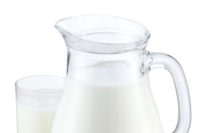According to a 2017 report from global market research firm Mintel, 75% of American adults are interested in consuming more protein. But as Orlaigh Matthews, business development manager – nutritional beverages for Beloit, Wis.-based Kerry pointed out, most Americans already consume adequate amounts of protein.
Yet why should that reality stop them? If the adults in Mintel’s survey are as concerned with health and wellness as trends would indicate, they’re probably clued-in to the headlines praising protein as a nutrient with little apparent downside.
“These consumers continue to look for healthy, convenient products to support their active lifestyles,” Matthews said, “and protein-fortified foods and beverages meet their demands.”
But how much do even wellness-minded consumers understand about the reasons protein is so important, how much is enough and which sources deliver the best payout per portion?
The answer, it’s safe to bet, is probably not a lot.
“There’s definitely room to increase consumers’ knowledge and understanding of protein quality,” said Lindsey Ormond, director of nutrition and research, Milk Specialties Global, Eden Prairie, Minn. “While protein’s role in achieving health and wellbeing goals is growing more well-known, the next step is to educate consumers that not all proteins are created equally.”
It might not hurt to educate dairy developers about that fact as well.
Constant request
The value of the global protein sector, per 2017 research from Indian market research firm MarketsandMarkets Research Private Ltd., is expected to hit $58.49 billion by 2022, reflecting a compound annual growth rate of 6%. As for individual introductions, the Innova Product Launch Database catalogued some 3,944 protein-packed debuts in 2017, up 11% from the year prior.
“Protein’s the one macronutrient that hasn’t really gotten any bad press,” observed Georgia Dina Konstantopoulos, communication manager for Paramus, N.J.-based FrieslandCampina Ingredients North America Inc. “That’s why customers feel comfortable formulating with protein, and as a result, we’ve seen a rise in product launches containing protein.”
Christine Addington, senior dairy technical service specialist for Minneapolis-headquartered Cargill Inc., agrees.
“It’s a constant request from our customers,” she said. “Even dairy processors regularly come to us looking to increase the protein in their products. Dairy is naturally high in protein, but there’s plenty of interest in making it even higher.
“We’re seeing this across the spectrum beyond standard dairy beverages and yogurt,” Addington continued. “Now we’re seeing it in ice cream, processed cheese and more.”
Green revolution
While dairy is a longstanding source for many of the protein ingredients developers use in their fortification efforts, the category no longer holds a “monopoly” on the protein ingredient market, as the past few years have seen a boom in plant-derived proteins that truly merits the descriptor “revolutionary.”
Rikka Cornelia, product manager for BI Nutraceuticals, Rancho Dominguez, Calif., tracked a 17% jump in sales of her company’s plant-based proteins in 2017.
“Plant proteins have kept the segment innovative and exciting while broadening the range of consumers, from individuals aiming to maintain a healthy lifestyle to vegetarians seeking protein supplementation,” she said.
Although health certainly drives much of this interest, it’s just one motivator among many.
“The perception — and reality — is that a plant-based diet includes more high-quality, nutrient-dense foods and is less burdensome on the environment than animal agriculture,” noted Samantha Ford, director of business development for AIDP, City of Industry, Calif.
That translates into a “cleaner,” more “natural” reputation for plant proteins — and that’s not a bad reputation to have. In fact, a recent survey from New York-based Nielsen (https://tinyurl.com/y8aghloj) found that 51% of U.S. consumers are turning to plant-based foods as a means of eating “clean.”
Mainstream health nuts
For a meat-loving nation, that’s a stunning statistic. And experts say that an increasingly mainstream inclination toward plant-based foods is here to stay. As, too, is Americans’ inclination toward protein.
“Protein has moved beyond the sports nutrition user into the mainstream as more consumers become interested in health and wellness,” Matthews noted.
Protein’s health dividends are well established and range from contributing to basic growth and function to playing roles in digestion, metabolism, cellular processing, healthy aging and more.
Of particular interest is protein’s connection to weight management. Studies suggest that high-protein diets can increase satiety hormones and perceptions of fullness, “particularly when participants are on a calorie-restrictive diet,” Cornelia noted.
Protein’s ability to promote muscle protein synthesis and the accumulation of lean body mass is crucial not just for athletes, but also for civilians hoping to age healthily, added Michael Kemp, nutrition manager – research, development and applications at Kerry.
“After age 30,” he explained, “we lose approximately 1% of our muscle mass per year,” he explained. “Muscle loss not only reduces sports performance but, over a lifetime, can result in disease and obesity. Long-term age-related muscle loss produces a condition called sarcopenia, which can be a major determinant of disability and loss of quality of life.”
The source matters
Jean Heggie, strategic marketing lead for DuPont Nutrition & Health, St. Louis, said her company’s internal research revealed a general consumer understanding of benefits attributable to broad protein categories such as dairy and plant. But when it comes to individual protein sources such as whey, soy or pea, shoppers are not as sure of the benefits.
“While they say that high-quality proteins are desirable, they don’t understand the finer points of protein quality or the differences in quality among individual sources.”
And if there’s one truth about protein quality, it’s that not all sources are created equal. Why? Chalk it up to amino acids. Proteins may be the building blocks of the body, but amino acids are the building blocks of protein.
The nine essential amino acids (EAAs) — histidine, isoleucine, leucine, lysine, methionine (plus cysteine), phenylalanine (plus tyrosine), threonine, tryptophan and valine — “are most important when defining quality protein,” said Paige Ties, senior technical service specialist, research and development for Cargill. The human body can’t synthesize these EAAs de novo, so they must get them from their diet.
At an even more granular level, the branched-chain amino acids (BCAAs) — leucine, isoleucine and valine — account for more than a third of the amino acids found in muscle.
“BCAAs promote signaling pathways, glucose metabolism and protein synthesis and turnover,” Kemp said. “Protein aficionados appreciate BCAAs because they include leucine, which is the trigger for muscle protein synthesis.”
Michelle Braun, Ph.D., global protein scientific affairs lead for DuPont Nutrition & Health, agrees.
“Several studies have connected delivery of circulating BCAAs with increased skeletal muscle metabolism,” she said. “In theory, proteins with a higher BCAA content will lead to greater muscle protein synthesis.”
Quality counts
So which proteins qualify?
“A big point of confusion with protein fortification is what, exactly, counts as complete protein,” Cornelia said. “Some believe it’s a protein that contains all nine essential amino acids, period. Others believe it’s a protein that contains all nine essential amino acids but at ‘sufficient amounts.’”
Currently, the most popular measure of protein quality is the digestibility corrected amino acid score, or PDCAAS, which “is based on the principle that the nutritive value of a protein depends on its ability to provide amino acids in adequate amounts to meet children’s and adults’ requirements,” Braun said.
But, she added, protein digestibility also is a critical part of the quality assessment equation. Thus, the Food and Agriculture Organization of the United Nations convened an expert panel in 2011 that in early 2013 reported a new method for protein quality consideration: the digestible indispensable amino acid score (DIAAS).
“DIAAS is emerging as the preferred technique because it gives a true protein score,” noted Jordan Donohue, business development manager for sports nutrition and health foods at Arla Foods Ingredients, Sønderhøj, Denmark.
“When assessing true ileal digestibility with PDCAAS,” he explained, “we see a lot of proteins achieving a score of 1” — the highest attainable on that scale. “But when using the newer DIAAS method, we record a wider variety of scores, which is much more helpful for formulators of nutrition products.”
Plant pitfalls
What those scores frequently tell formulators is that, popularity notwithstanding, plant proteins largely do not contain the full spectrum of amino acids at high enough levels to qualify as complete proteins. For example, pea protein contains all essential amino acids but falls short because of limited methionine and cysteine.
“To compensate,” Ties explained, “formulators can blend pea protein with a complementary protein source like chickpea, soy, pumpkin or rice,” the last of which has higher methionine and cysteine levels to make up for what pea protein lacks.
And plant protein/dairy protein blends let formulators fine-tune flavor, function and cost.
“We’ve conducted sensory research demonstrating that formulators can drive better flavor in high-protein beverages with blends of dairy and soy proteins compared to using either all soy or all dairy,” Heggie said. “Of course, such blends also drive better economics than all-dairy formulations.”
Beyond blends, improved protein ingredients can now deliver a more advantageous amino acid balance.
“Processing, manufacturing and testing methods are continuously becoming more sophisticated in the plant protein arena,” Ford said. “This is allowing us to maximize the proportion of high-quality protein content within plant powders. We’re also able to blend multiple sources to create the most desirable amino acid profiles and apply processing techniques to improve organoleptic attributes like taste, texture and mouthfeel.”
For its part, Minneapolis-based PURIS, which began more than three decades ago as a seed company, has been working on pea breeding enhancements.
“Advances in flavor, color and even amino acid composition continue to be part of the mix our breeders have an eye on,” said Jon Getzinger, the company’s chief marketing officer. “The protein content of our peas is substantially higher than what’s typically found elsewhere.”
Don’t discount dairy
Novel plant protein blends and dairy/plant protein blends are a huge leap forward for the category overall. But as Max Maxwell, manager, market intelligence for Glanbia Nutritionals, Chicago, noted, “Dairy-based proteins are already complete, so blending isn’t essential for nutritional purposes.”
Donohue pointed to other dairy protein benefits.
“Dairy proteins outperform plant proteins across every parameter,” he maintained. “They’re absorbed faster, have superior amino acid profiles — including an abundance of muscle-building leucine — build more muscle gram for gram and are significantly easier to work with from an application and taste standpoint.”
Another plus is the fact that dairy proteins tend to be less processed than their alternatives, added Kara McDonald, vice president of global marketing communications for the Arlington, Va.-based U.S. Dairy Export Council.
“Because dairy proteins are naturally water soluble, they require fewer processing steps or chemical additions to keep them in solution versus plant- or nut-based sources,” she said.
That’s not to say plant proteins should be ignored.
“We’re always being asked about proteins from other sources, especially plant,” Donohue said. “And we always say that dairy proteins, and especially whey, are the best for many reasons. But we also believe that as with any market, a wider product offering increases the popularity of a category, and this is definitely the case here.”





